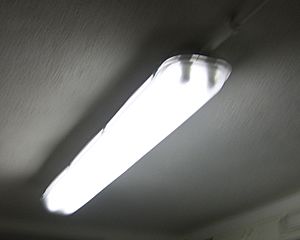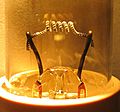Fluorescent lamp facts for kids
A fluorescent lamp is a special type of electric light. It works by using ultraviolet light from mercury vapor to make a special coating, called a phosphor, glow. This glowing phosphor then creates the visible light we see. There are two main kinds: the traditional long tube shape and compact fluorescent lamps (CFLs), which are often spiral-shaped. This article focuses on the traditional tube-shaped fluorescent lamps.
Even though fluorescent lamps often cost more to buy than old-fashioned incandescent bulbs, they save a lot of money in the long run. They last much longer and use a lot less energy. A single fluorescent lamp can save over US$30 in electricity costs during its lifetime compared to an incandescent bulb of the same brightness!
Contents
How Fluorescent Lamps Make Light
When you turn on a fluorescent lamp, an electric current flows through the mercury vapor inside the glass tube. This current makes the mercury vapor give off ultraviolet (UV) light. You can't see UV light with your eyes.
The inside walls of the tube are covered with a special material called a phosphor. When the invisible UV light hits this phosphor, it makes the phosphor glow and produce visible light. It's like a magic trick where invisible light is changed into light you can see!
What Does a Ballast Do?
Every traditional fluorescent lamp needs a device called a ballast. Think of the ballast as a traffic cop for electricity. It stops too much electricity from flowing through the lamp, which could damage it. The ballast also gives the lamp a quick, high burst of voltage when you first switch it on, helping it start up.
In traditional tube lights, the ballast is usually hidden inside the light fixture. For compact fluorescent bulbs, the ballast is often built right into the base of the bulb.
There are two main types of ballasts: magnetic and electronic. Older magnetic ballasts are not used much anymore because they waste more energy, can make the light flicker, and don't turn on instantly. Modern electronic ballasts are much better. They are more efficient, start instantly, and now cost about the same as the older magnetic ones.
How Long Do Fluorescent Lamps Last?
Fluorescent lamps last a lot longer than traditional incandescent light bulbs. On average, a fluorescent bulb can last 8 to 15 times longer! Most fluorescent lamps are designed to work for 7,000 to 15,000 hours. In comparison, incandescent bulbs usually only last about 750 to 1,000 hours.
Many things can affect how long any light bulb lasts. These include the voltage it uses, any manufacturing defects, sudden power surges, or even if it gets bumped. How often you turn the light on and off also matters a lot for fluorescent lamps.
If you turn a fluorescent lamp on and off very often, like every 5 minutes, its lifespan can become much shorter. It might even last only as long as an incandescent bulb. To avoid this, the U.S. Energy Star program suggests leaving fluorescent lamps on if you're only leaving a room for less than 15 minutes. If a light needs to be switched on and off all the time, special Cold cathode fluorescent lamps can be used, as they are built for many more on/off cycles.
Mercury and Recycling Fluorescent Lamps
Fluorescent lamps contain a small amount of mercury inside the tube. Mercury is a toxic substance, which means these bulbs are considered hazardous waste when they stop working.
It's very important to take used fluorescent bulbs to a recycling center. This makes sure the mercury is handled safely and doesn't harm the environment. During normal use, the mercury is safely sealed inside the bulb and cannot escape. However, if a bulb breaks, the mercury vapor can be released.
If a single bulb breaks, it's usually not a big problem. It's a good idea to open windows to let fresh air into the room. When cleaning up the broken glass, it's best to use duct tape to pick up small pieces instead of a vacuum cleaner. A vacuum cleaner could spread the mercury vapor around.
Other Lighting Choices
Some people and businesses prefer not to use fluorescent lamps because of the mercury they contain. There are several other options available:
You can even install LED tubes in light fixtures designed for fluorescent tubes. Sometimes, an electrician might need to change the wiring in the fixture first to remove the ballast, as LED lights don't need one.
Related pages
Images for kids
-
A Compact fluorescent lamp (CFL) with an electronic ballast at its base.
-
Peter Cooper Hewitt, an inventor.
-
Close-up of the parts that create light in a germicidal lamp.
-
A germicidal lamp uses a similar process to a fluorescent lamp, but it lets out ultraviolet light.
-
Light from a fluorescent tube seen through a CD shows different colors.
-
A spiral cool-white fluorescent lamp's light seen through a diffraction grating shows its spectral lines.
-
Capacitive coupling with high-voltage power lines can make a lamp glow faintly.
-
One of the first mercury vapor lamps, invented by Peter Cooper Hewitt in 1903.
See also
 In Spanish: Luminaria fluorescente para niños
In Spanish: Luminaria fluorescente para niños


























